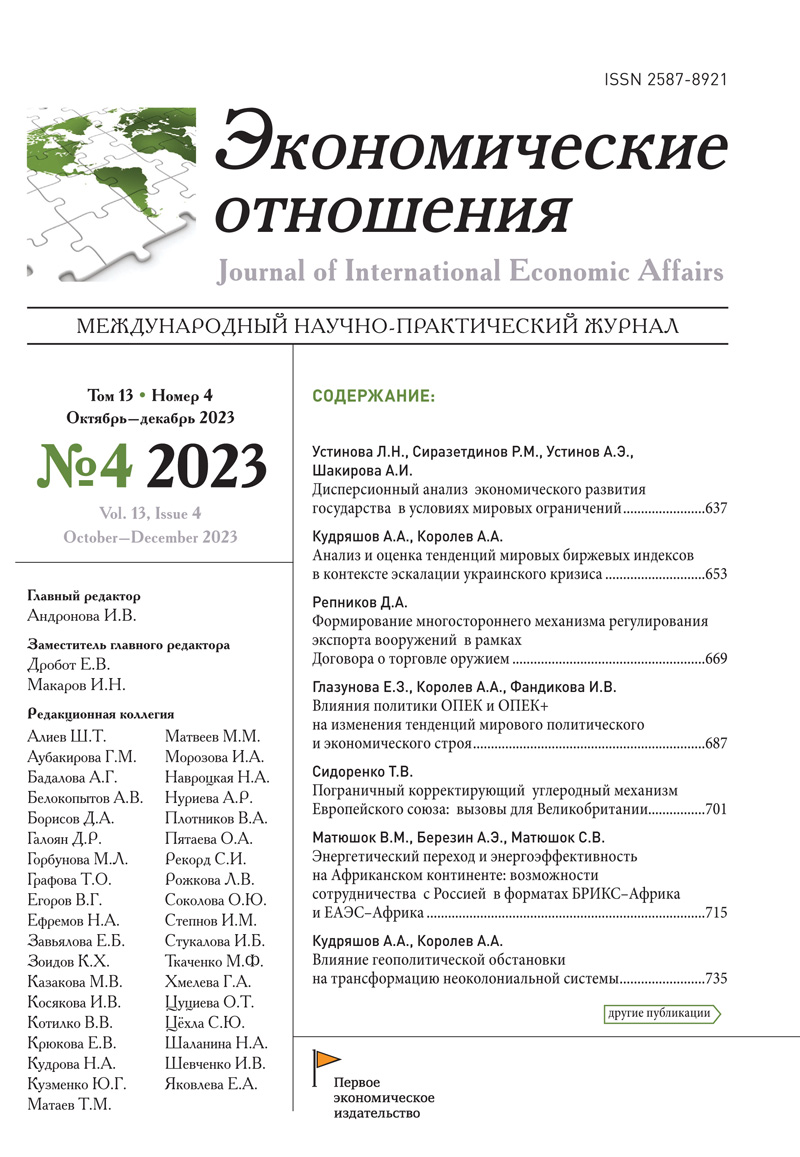Региональная фрагментация банковской инфраструктуры стран Северной Африки
- Авторы: Шелен И.В.1
-
Учреждения:
- Институт Африки Российской академии наук
- Выпуск: Том 13, № 4 (2023)
- Страницы: 773-788
- Раздел: Статьи
- URL: https://journals.eco-vector.com/2587-8921/article/view/625052
- DOI: https://doi.org/10.18334/eo.13.4.119358
- ID: 625052
Цитировать
Полный текст
Аннотация
Интеграционные объединения на африканском континенте достаточно редко представляют собой долгосрочные и успешные проекты. Причины этого заключаются в том, что за образцы механизмов взаимодействия между субъектами интеграции зачастую выбираются механизмы европейских или американских интеграционных моделей, которые, однако, функционируют в иных условиях, чем страны Африки. В настоящей статье проверяется гипотеза о том, что банковская инфраструктура североафриканских стран подвержена рыночным провалам (market failure) по части финансирования внешней торговли из-за чего формирование эффективного регионального интеграционного объединения затруднительно. Полученные результаты свидетельствуют о том, что из всех стран североафриканского региона только Марокко и в меньшей степени Египет обладают развитой банковской инфраструктурой поддержки торговли, хотя и испытывают ряд трудностей по части финансирования услуг. В то же самое время, для Алжира, Ливии и Туниса с ростом экспорта наблюдается снижение роли национальной банковской инфраструктуры, которое выражается в падении показателей соответствующих статей консолидированного баланса банков. Также установлено, что за период 2007-2021 гг. внешняя торговля Судана почти никак не соотносилась с финансовой поддержкой, исходящей от местных банков
Об авторах
Иван Владимирович Шелен
Институт Африки Российской академии наук
Email: zunku@mail.ru
аспирант
Список литературы
- 1. Abiad A., Mishra P., Topalova P. How does trade evolve in the aftermath of financial crises? // IMF Economic Review. – 2014. – p. 213-247.
- 2. Ahn J. B., Amiti M., Weinstein D. E. Trade finance and the great trade collapse // American Economic Review. – 2011. – № 3. – p. 298-302.
- 3. Amiti M., Weinstein D. E. Exports and financial shocks // The Quarterly Journal of Economics. – 2011. – № 4. – p. 1841-1877.
- 4. Araújo S. The Great Synchronisation: tracking the trade collapse with high-frequency data // Paris Dauphine University. – 2011. – № 123.
- 5. Bems R., Johnson R. C., Yi K. M. The great trade collapse // Annu. Rev. Econ. – 2013. – № 1. – p. 375-400.
- 6. Benguria F., Taylor A. M. After the panic: Are financial crises demand or supply shocks? Evidence from international trade // American Economic Review. – 2020. – № 4. – p. 509-526.
- 7. Bussière M. Estimating trade elasticities: demand composition and the trade collapse of 2008–2009 // American Economic Journal: Macroeconomics. – 2013. – № 3. – p. 118-151.
- 8. Ferri G., Minetti R., Murro P. Credit Relationships in the great trade collapse. Micro evidence from Europe // Journal of Financial Intermediation. – 2019. – p. 100809.
- 9. Hakimian H., Nugent J. B. Trade policy and economic integration in the Middle East and North Africa: Economic boundaries in flux. – Routledge, 2004
- 10. Iacovone L. Banking crises and exports: Lessons from the past // Journal of Development Economics. – 2019. – p. 192-204.
- 11. International merchandise trade, International trade in service. UNCTADstat. [Электронный ресурс]. URL: https://unctadstat.unctad.org/wds/ReportFolders/reportFolders.aspx?IF_ActivePath=P,15912sCS_ChosenLang=en (дата обращения: 01.08.2023).
- 12. Issawi C. An economic history of the Middle East and North Africa. – Routledge, 2013
- 13. Lagoarde-Segot T., Lucey B. M. Capital market integration in the Middle East and North Africa // Emerging Markets Finance and Trade. – 2007. – № 3. – p. 34-57.
- 14. Laureys L. The great trade collapse: an analysis of the underlying determinants. [Электронный ресурс]. URL: https://libstore.ugent.be/fulltxt/RUG01/002/784/330/RUG01-002784330_2019_0001_AC.pdf (дата обращения: 01.08.2023).
- 15. Reinhart C. M., Rogoff K. S. The aftermath of financial crises // American Economic Review. – 2009. – № 2. – p. 466-472.
- 16. Trade map. The International Trade Center. [Электронный ресурс]. URL: https://www.trademap.org/Index.aspx (дата обращения: 28.07.2023).
- 17. Yu J. S., Hassan M. K. Global and regional integration of the Middle East and North African (MENA) stock markets // The Quarterly Review of Economics and Finance. – 2008. – № 3. – p. 482-504.
- 18. Багдасарян К. М. Анализ модели экономической интеграции // Журнал экономической теории. – 2019. – № 3. – c. 352-361.
- 19. Годовой отчет о банковском надзоре. Марокко. [Электронный ресурс]. URL: https://www.bkam.ma/en/Banking-supervision/Publications/Annual-report-on-banking-supervision (дата обращения: 03.08.2023 г.).
- 20. Годовые отчеты. Центральный банк Судана. [Электронный ресурс]. URL: https://cbos.gov.sd/en/periodicals-publications?field_publication_type_tid_i18n=43 (дата обращения: 02.03.2023 г.).
- 21. Денежно-кредитная и банковская статистика. Центральный банк Ливии. [Электронный ресурс]. URL: https://cbl.gov.ly/en/indicators-of-banking-sector/ (дата обращения: 15.08.2023 г.).
- 22. Конъюнктурный обзор. Банк Алжира. [Электронный ресурс]. URL: https://www.bank-of-algeria.dz/notes-de-conjoncture/ (дата обращения: 15.08.2023 г.).
- 23. Костюнина Г. М. Интеграционные процессы в Африке: история и современный этап // Российский внешнеэкономический вестник. – 2016. – № 4. – c. 34-50.
- 24. Отчет о банковском надзоре. Центральный банк Туниса. [Электронный ресурс]. URL: https://www.bct.gov.tn/bct/siteprod/page.jsp?id=77 (дата обращения: 03.08.2023).
- 25. Публикации. Центральный банк Египта. [Электронный ресурс]. URL: https://www.cbe.org.eg/en/news-publications/publications (дата обращения: 01.06.2023 г.).
- 26. Центральный банк Мавритании. [Электронный ресурс]. URL: https://www.bcm.mr/statut (дата обращения: 10.08.2023 г.).
Дополнительные файлы









